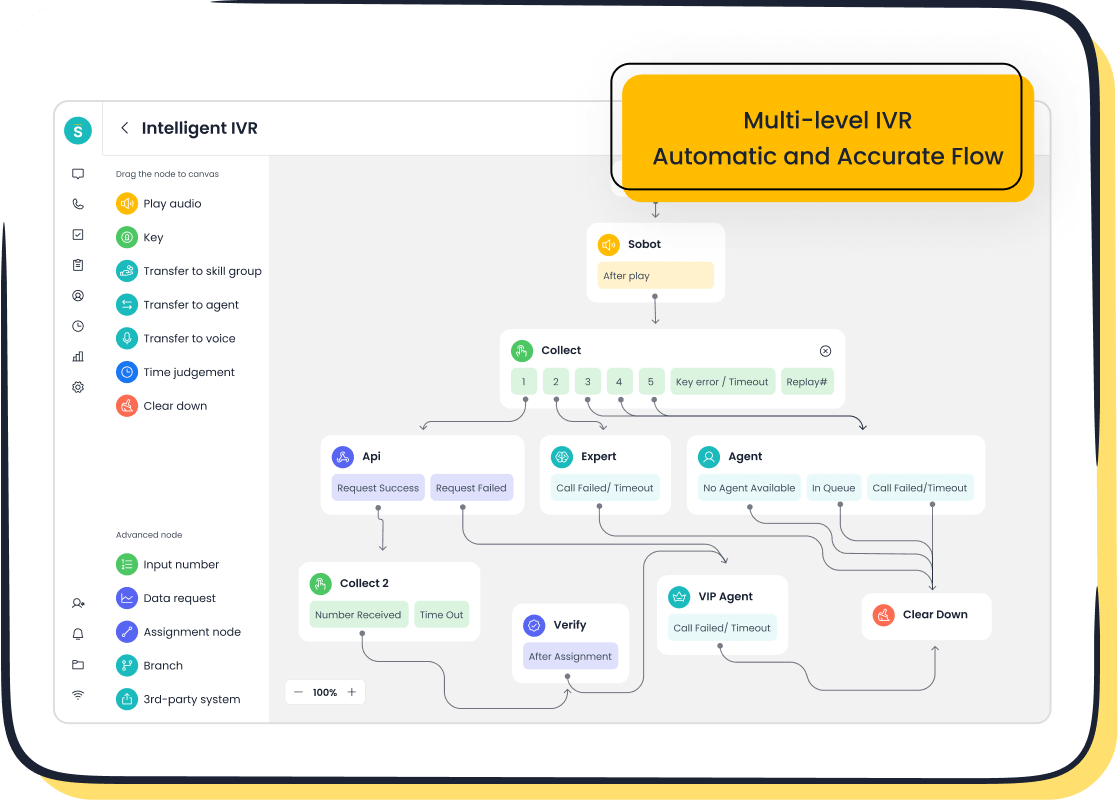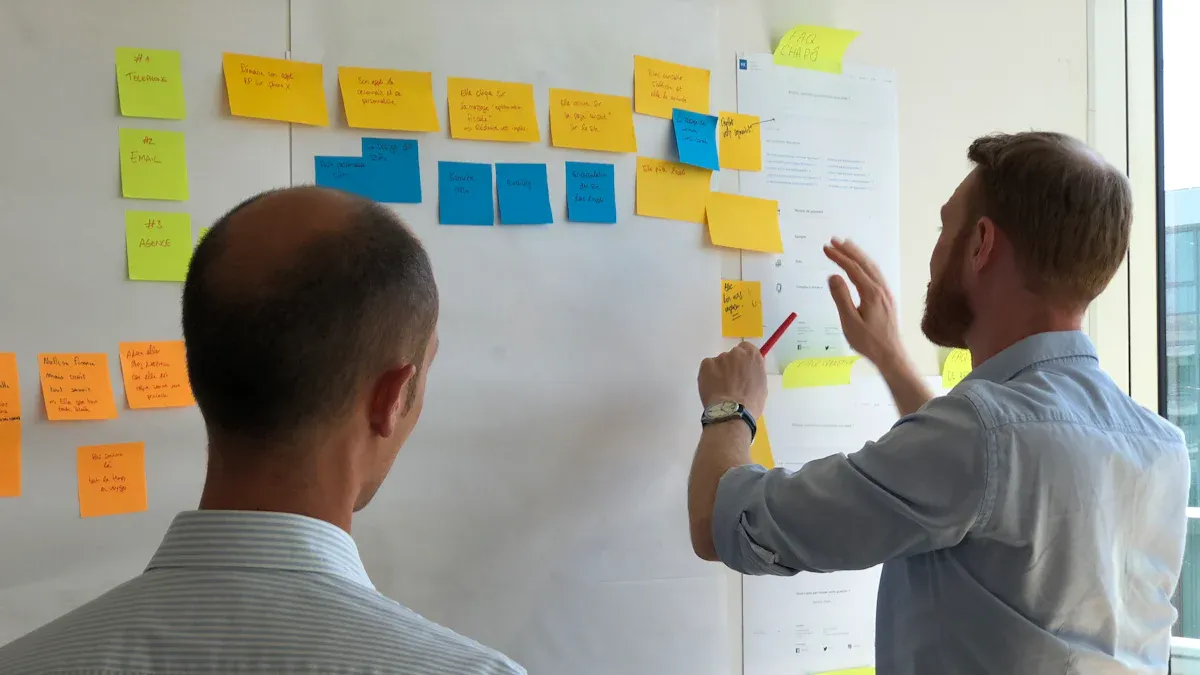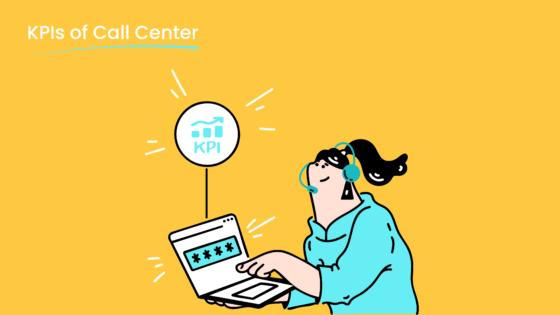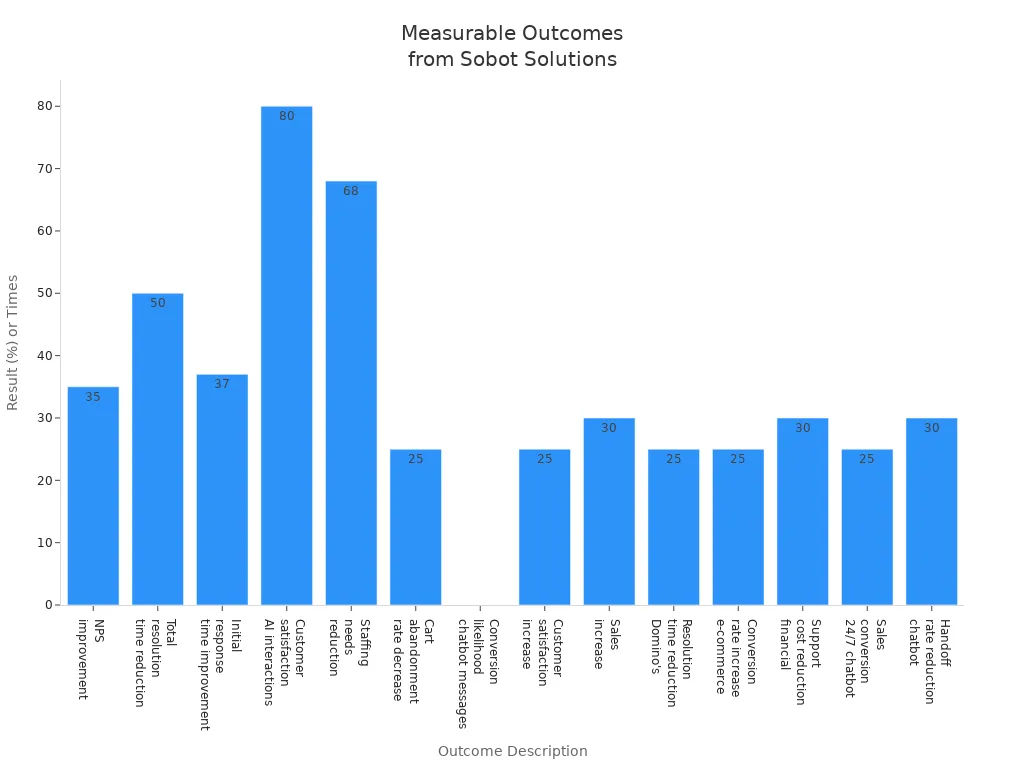Customer journey training tips for building your first map

If you want to master customer journey training for your business, start by understanding how every step shapes the customer experience. A customer journey map helps you see what your customers go through from start to finish. This tool makes it easy to spot pain points and improve customer service, especially in busy contact centers or ecommerce shops. Almost 90% of companies using customer journey mapping report higher customer retention, fewer complaints, and a boost in satisfaction. When you use customer journey training, you get a full view of the customer experience, find problems fast, and create better moments for each person. Sobot and Sobot AI lead the way with smart solutions that make mapping simple. With Sobot call center tools, you can build your first customer journey map with confidence and start seeing real results.
Customer journey map basics

What is a customer journey map?
You might wonder what a customer journey map is and why it matters. A customer journey map shows every step your customers take when they interact with your business. You can see how people move from learning about your brand to buying and getting support. In contact centers and ecommerce, a user journey map helps you track actions, thoughts, and feelings at each stage. You get a clear picture of what works and what needs fixing.
Here’s a simple table showing common stages and touchpoints in a user journey map for contact centers and ecommerce:
| Stage | Touchpoints |
|---|---|
| Research | Search engines, social media, product reviews, blogs, forums |
| Shop | E-commerce platforms, product listings, recommendations, offers |
| Purchase | Payment pages, checkout, confirmation, delivery updates, order tracking |
| Service | Self-service portals, chatbots, support channels (email, phone, social media), feedback |
A customer journey template includes all these touchpoints. You can use a customer journey template to map out each action and emotion. Sobot’s chatbot, live chat, and voicebot make it easy to collect data at every step.
Why mapping matters for customer service
When you use customer journey mapping, you break down silos between teams. Marketing, sales, and support work together to help customers. You can spot pain points and improve the user journey map. Mapping lets you deliver the right message at the right time. You can track conversion rates and customer satisfaction with a customer journey template.
Customer journey mapping helps you empathize with your customers. You see what they feel and need. You can challenge your own assumptions and make changes that boost customer experience. Sobot’s call center and ticketing system help you gather feedback and analyze data for your user journey map.
Sobot’s approach to customer journey training
Sobot believes in making customer journey mapping simple and effective. You get tools like AI Agent, WhatsApp Business API, and a unified workspace. Sobot’s mission is to help you improve customer experience and agent efficiency. With Sobot, you can build a user journey map using a customer journey template and see real results. You can join a customer journey mapping workshop to learn best practices. Sobot’s solutions let you visualize every step, find pain points, and create better moments for your customers.
Tip: Use a customer journey template to keep your user journey map organized and easy to update.
How to create a customer journey map

Ready to build your first customer journey map? You’re in the right place. Let’s walk through a step-by-step guide that makes customer journey mapping simple, even if you’re just starting out. You’ll learn how to set objectives, build customer personas, and list all touchpoints. Along the way, you’ll see how Sobot’s Voice/Call Center features help you map the current journey and improve customer experience.
Set objectives and goals
Before you start drawing your customer journey map, you need clear goals. What do you want to achieve with customer journey mapping? Maybe you want to boost customer satisfaction, reduce complaints, or increase sales. Setting objectives helps you stay focused and measure success.
Here’s a step-by-step guide to setting objectives for your customer journey:
- Define clear objectives. Decide what you want to improve in the customer experience.
- Gather customer data. Use feedback, surveys, and call logs from Sobot’s unified workspace.
- Identify touchpoints. List all touchpoints where customers interact with your business.
- Map the current journey. Draw out each step your customers take.
- Analyze insights. Look for patterns in customer behavior and feedback.
- Identify gaps and opportunities. Spot areas where customers struggle or drop off.
- Brainstorm improvements. Think of ways to make each step easier or more enjoyable.
- Prioritize actions. Choose the most important changes to tackle first.
- Implement changes. Use Sobot’s Voice/Call Center tools to update processes.
- Measure results. Track progress using Sobot’s call tracking and analytics.
Tip: When you set objectives, make them specific and measurable. For example, aim to increase your customer satisfaction score by 10% in three months.

Sobot’s Voice/Call Center features make it easy to gather data and measure results. You can track calls, monitor agent performance, and see how changes affect customer experience. Samsung used this approach and saw a 30% increase in agent efficiency and a 97% customer satisfaction score. Read more about Samsung’s success with Sobot.
Build customer personas
You can’t map the current journey without knowing who your customers are. Building customer personas helps you understand their needs, motivations, and pain points. A persona is a simple profile of a typical customer. You can use real data from Sobot’s Voice/Call Center to make your personas accurate.
Here’s a step-by-step guide to building customer personas:
- Collect customer feedback from support calls and chat transcripts.
- Run surveys to ask customers about their experiences.
- Interview customers to learn what matters most to them.
- Review chat transcripts for common questions and issues.
- Check support logs for patterns in complaints or requests.
- Analyze web analytics to see how customers use your site.
- Monitor social media interactions for trends and feedback.
| Data Source | Description |
|---|---|
| Customer Feedback | Insights directly from customers about their experiences. |
| Surveys | Structured questions to gather customer opinions. |
| Interviews | In-depth discussions to understand customer motivations. |
| Chat Transcripts | Records of customer interactions for behavioral insights. |
| Support Logs | Historical data on customer issues and resolutions. |
| Web Analytics | Data on customer behavior on websites. |
| Social Media Interactions | Engagement and feedback from social platforms. |
Note: Sobot’s unified workspace lets you collect and organize all this data in one place. You can quickly spot trends and build personas that reflect your real customers.
When Samsung mapped the current journey, they used data from multiple channels. They created personas for VIP customers and regular shoppers. This helped them customize support and improve customer experience for everyone.
Identify key touchpoints
Now you’re ready to list all touchpoints. These are the moments when customers interact with your business. Touchpoints can include ads, social media, product searches, reviews, cart additions, checkout, and support calls. You need to map the current journey by listing every touchpoint, so you don’t miss any important steps.
Here’s a step-by-step guide to identifying key touchpoints:
- Start with ads and social media. Track how customers find your brand.
- Follow the journey through product searches and reviews.
- List all touchpoints in the shopping process, like adding items to the cart and checking out.
- Include support channels, such as phone calls, chatbots, and email.
- Don’t forget newsletters, delivery updates, and feedback requests.
Sobot’s Voice/Call Center features help you list all touchpoints by integrating every communication channel into one platform. You can see calls, chats, emails, and social media messages in a unified workspace. This makes it easy to map the current journey and spot areas for improvement.
Tip: Use Sobot’s call tracking and analytics to monitor customer touchpoints in real time. You’ll get a complete view of the customer journey and find ways to improve customer experience.
Samsung’s story shows how powerful this approach can be. By mapping every touchpoint, they increased agent efficiency by 30% and boosted pre-sales conversion rates by 15%. Their customer satisfaction score reached 97%, proving that a detailed customer journey map leads to real results.
| Advantage | Result |
|---|---|
| Efficiency | 30% increase in agent efficiency |
| Customer Satisfaction | 97% Customer Satisfaction (CSAT) score |
| Sales Conversion | 15% increase in pre-sales conversion rates |
Common challenges and how to overcome them
When you start customer journey mapping, you might face some challenges. You could feel overwhelmed by the volume of data or struggle to keep up with changes in customer behavior. Sometimes, different teams don’t share information, making it hard to see the full picture.
Here are some common challenges:
- Data overload from too many touchpoints.
- Diverse customer behaviors that make mapping tricky.
- Changes in customer habits that require frequent updates.
- Lack of transparency between departments.
Note: Sobot’s omnichannel platform solves these problems by bringing all your data together. You get a clear view of the customer journey, so you can update your customer journey map easily and keep improving customer experience.
Your step-by-step guide to success
Let’s recap how to create a customer journey map with Sobot:
- Set clear objectives for your customer journey mapping project.
- Build customer personas using real data from Sobot’s Voice/Call Center.
- List all touchpoints across every channel.
- Map the current journey and look for pain points.
- Use Sobot’s unified workspace and call tracking to analyze results.
- Make improvements and measure success.
You now have a step-by-step guide that makes customer journey mapping easy. Sobot’s tools help you map the current journey, list all touchpoints, and improve customer experience at every stage. With this approach, you can create a customer journey map that drives real business results.
Create customer journey maps with Sobot
When you create customer journey maps with Sobot, you get a clear, organized view of every step your customers take. Sobot’s solutions make it easy to track actions, emotions, and key pain points. You can involve your whole team, gather the right data, and visualize the journey with powerful tools. Let’s break down how you can use Sobot to build a customer journey map that truly improves customer experience.
Mapping actions, emotions, and pain points
You want to see your business through your customers’ eyes. Start by mapping what your customers do, think, and feel at each stage. Sobot’s Voice/Call Center and omnichannel support help you collect this information from every channel—calls, chats, emails, and more.
Here’s how you can map actions, emotions, and pain points:
- Write down each action your customer takes. Use sticky notes or digital tools to plot these steps on your customer journey map.
- For every action, ask yourself: What is the customer thinking? How do they feel? Note these thoughts and emotions next to each step.
- Identify key pain points by looking for moments of frustration or confusion. Mark these on your map so you know where to focus improvements.
- Draw a simple line or chart to show how customer emotions change along the journey. This helps you spot highs and lows at a glance.
- Step back and look at the big picture. Discuss trends with your team and find areas where you can make the biggest impact.
When you create customer journey maps this way, you get a deeper understanding of your customers. You see where they struggle and where they feel happy. Sobot’s AI-powered features help you analyze these patterns quickly. You can use real-time call transcripts, chat logs, and feedback to spot trends and make changes fast.
Tip: Mapping emotions and pain points helps you focus on what matters most. You can fix problems before they turn into complaints.
Involve teams and gather data
You can’t create customer journey maps alone. The best maps come from teamwork. Sobot’s unified workspace brings everyone together—sales, marketing, support, and product teams. When you involve all departments, you get a complete view of the customer journey.
Here’s why cross-functional collaboration matters:
- You get buy-in from every team early. This makes it easier to put your action plan into practice.
- Involving all departments from the start prevents gaps in your customer journey map.
- Teams share their unique insights, so you don’t miss important details.
- Collaboration creates a shared understanding of customer experience. Everyone works toward the same goal.
- You avoid working in silos, which can lead to a narrow view of the customer journey.
To gather the right data, use Sobot’s omnichannel support. This feature merges all your communication channels, so you can collect detailed information about every customer interaction. You see how customers move from one touchpoint to another, and you can spot key pain points quickly.
Here’s a table showing the types of data you should collect:
| Type of Data | Description |
|---|---|
| Solicited Data | Feedback from surveys like CSAT, NPS, or CES. Shows what customers think and feel. |
| Unsolicited Data | Data from purchase history, website visits, and interactions. Reveals behavior without direct feedback. |
Sobot’s AI tools help you organize and analyze this data. You can see patterns, track changes, and make decisions based on real customer experiences. This makes your customer journey mapping more accurate and effective.
Note: When you involve your whole team and use Sobot’s unified workspace, you create customer journey maps that reflect the real customer journey—not just one department’s view.
Visualize with templates and tools
Now it’s time to bring your customer journey map to life. Visualization helps everyone understand the journey at a glance. Sobot offers templates and tools that make this step easy, even if you’re new to customer journey mapping.
You can use many popular tools to visualize your customer journey:
- SVG or EPS stencils for complex journeys with many steps.
- Figma and Sketch for digital prototypes.
- UXPressia and Custellence for dedicated journey mapping.
- PowerPoint and Google Slides for simple, shareable maps.
- Contentsquare for deep customer journey analysis.
- Miro for online whiteboard brainstorming.
- Smaply and Gliffy for mapping and collaboration.
Sobot’s integration capabilities let you connect these tools with your existing systems. You can pull in data from your CRM, website, or support channels. Sobot’s AI features help you update your maps automatically as new data comes in. This means your customer journey map always stays current.
Here’s how Sobot’s AI-powered features make visualization easier:
- Set clear objectives for your customer journey mapping project.
- Gather data from interviews, surveys, and behavior analysis.
- Build customer profiles based on real insights.
- Highlight the most important personas.
- List every customer touchpoint.
- Map the current journey and see how customers move through your business.
- Map the ideal journey to show what the best experience looks like.
- Check your resources and tools.
- Walk through the journey yourself to spot gaps.
- Make changes to match customer expectations.
Sobot’s omnichannel support means you always have the latest data. You can see every step, every emotion, and every pain point. This helps you create customer journey maps that drive real improvements in customer experience.
Tip: Use Sobot’s templates to save time. You can customize them for your business and update them as your customer journey changes.
When you create customer journey maps with Sobot, you get more than just a diagram. You get a living tool that helps you understand your customers, fix problems, and deliver a better customer experience. You can map the ideal journey, track progress, and keep your team focused on what matters most.
If you want to see how this works in real life, look at how Samsung used Sobot to unify their channels and boost customer satisfaction. They mapped every step, involved every team, and used Sobot’s tools to visualize and improve the journey. The result? A 97% customer satisfaction score and a 30% increase in agent efficiency.
Start building your customer journey map with Sobot today. You’ll see the difference in every customer interaction.
Optimizing your customer journey map
Review and update regularly
You need to keep your customer journey map fresh. Customer needs change fast, and your business grows. Industry leaders say you should review your customer journey map at regular intervals, like every quarter, or whenever you launch new products or services.
"If there are major changes happening more frequently in your industry, you might want to review and update your map quarterly."
When you review your map, look at real data from Sobot’s analytics platform. Sobot uses AI to give you real-time insights and automate workflows. This helps you spot changes in customer behavior and update your map quickly. Always check how customers feel at each stage. Telus found that tracking customer emotions helped them fix website issues and make plan choices easier. Regular feedback lets you catch pain points early and improve customer experience.
Avoid common pitfalls
Many beginners make the same mistakes when working on customer journey mapping. Here are some things to watch out for:
- Not defining who your customer is or what they need.
- Starting the map from your company’s view, not the customer’s.
- Ignoring offline or multi-channel customer touchpoints.
- Using guesses instead of real research.
- Skipping clear goals for your customer journey map.
- Building weak personas that do not match real customers.
You can avoid these problems by using Sobot’s unified workspace. It brings together feedback, call logs, and chat data, so you always work with real information. Make sure you focus on the customer’s journey, not just your internal process.
Best practices for beginners
You want your customer journey mapping to work well from the start. Try these best practices:
| Best Practice | Description |
|---|---|
| Map Longer Sales Cycles | Show every stage, including onboarding and support. |
| Emphasize Relationship-Building Touchpoints | Add follow-ups and check-ins to build trust. |
| Provide Comprehensive Information | Give customers all the details they need to decide. |
| Simplify the Journey | Remove extra steps to make buying easy. |
| Optimize Digital Touchpoints | Make your website and checkout smooth and fast. |
| Use Personalization | Show content that matches each customer’s behavior. |
| Incorporate Social Proof | Add reviews and testimonials to build trust. |
Sobot’s analytics and feedback tools help you track key metrics at every stage. Here are some you should watch:
| Stage | Key Metrics |
|---|---|
| Awareness | Traffic source, reach, impressions |
| Consideration | Engagement, sign-ups, inquiries |
| Purchase | Conversion rates, average order value |
| Usage | Customer goals, complaints, effort scores |
| Advocacy | NPS, CSAT, customer reviews |
| Re-purchase | Lifetime value, repeat purchase rate |
Keep listening to your customers. Use Sobot’s support and analytics to keep optimizing your customer journey map. When you do this, you create a better customer experience and build loyalty over time.
You now know the key steps to build your first customer journey map. Start by tapping into real-time insights and rich customer data. Build a customer-first culture and define clear goals for your customer journey. Involve your team, use buyer personas, and make your map accessible for feedback. Sobot’s solutions help you track every customer journey stage and improve customer experience fast.
When you use Sobot, you see real results. Check out these outcomes:
| Outcome Description | Measurable Result |
|---|---|
| Net Promoter Score improvement | Over 35% |
| Reduction in total resolution time | 50% |
| Increase in customer satisfaction | 25% |
| Increase in sales | 30% |

You can make your customer journey map work for you. Define your goal, tailor your map, and keep your team involved. With Sobot, you can boost customer experience and see your customer journey improve at every step.
FAQ
What is a customer journey map?
A customer journey map shows every step your customer takes with your business. You can see where they start, what they do, and how they feel. This helps you understand their experience and find ways to make it better.
How often should I update my customer journey map?
You should review your customer journey map at least every few months. If your business changes or you launch new products, update it sooner. Regular updates help you keep up with your customers’ needs.
Who should be involved in creating a customer journey map?
You should include people from sales, marketing, support, and product teams. Each group sees different parts of the customer journey. When everyone works together, you get a complete picture and better ideas for improvement.
What tools can help me build a customer journey map?
You can use digital tools like Sobot’s unified workspace, online whiteboards, or journey mapping templates. These tools help you organize steps, track feedback, and see the whole customer journey in one place.
How does mapping the customer journey improve customer experience?
When you map the customer journey, you spot pain points and fix them fast. You can see what makes customers happy or frustrated. This lets you create smoother experiences and build stronger relationships.
See Also
Enhancing Customer Satisfaction Through Effective Live Chat Strategies
Expert Techniques for Optimizing Live Chat Support Services
Effective Strategies for Managing Live Chat Support Teams
Transforming Customer Support with AI-Powered Service Agents
A Comprehensive Approach to Omnichannel Contact Center Implementation
